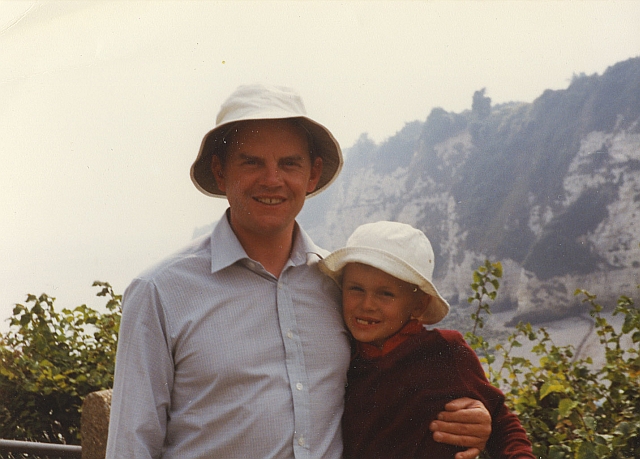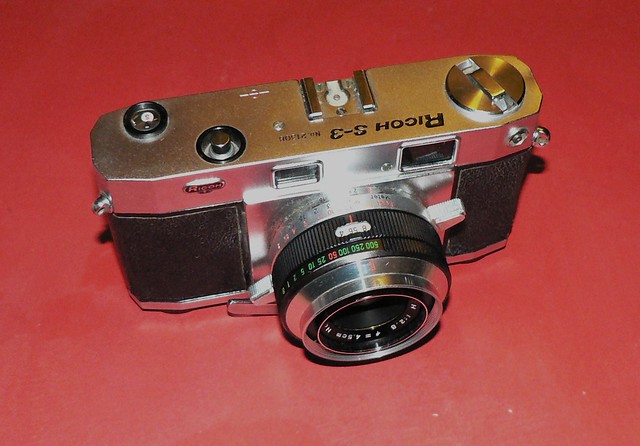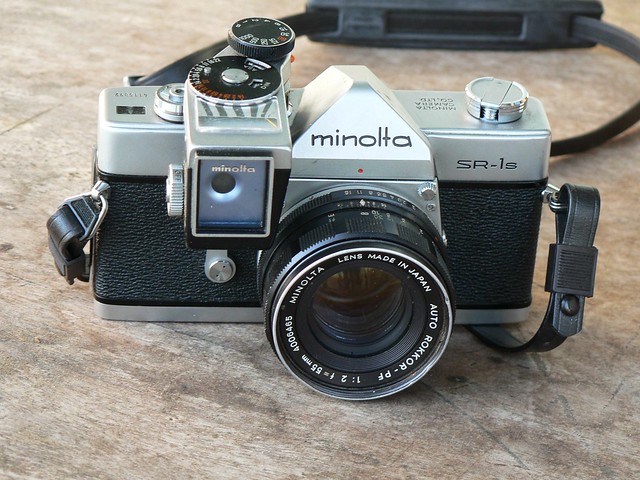| View previous topic :: View next topic |
| Author |
Message |
peterqd


Joined: 28 Feb 2007
Posts: 7448
Location: near High Wycombe, UK
Expire: 2014-01-04
|
 Posted: Sat Jul 19, 2008 6:28 pm Post subject: Praktica Nova 1B (1967) Posted: Sat Jul 19, 2008 6:28 pm Post subject: Praktica Nova 1B (1967) |
 |
|
peterqd wrote:
Would you like to meet my old camera? When I bought this in 1969 it was only 2 years old and 39 years later it is still working properly without ever having had a service. I paid �30 10s 0d for it and traded in my little Zenit 3M, which had developed a shutter fault, and for over 20 years this was my only camera. At a guess it must have gone through around 300 film rolls, mostly Kodachrome II.


It was a quite a step up over the little 3M. With no Ebay in those days it wasn't easy to find affordable M39 lenses for the 3M and this camera had the M42 mount with a much wider choice of lenses. The other main improvements were a wider range of shutter speeds and, wonders of wonders, a built-in light meter! This featured a selenium cell on the front of the body above the lens and an uncoupled needle in a window on the top of the camera. The needle is not visible in the viewfinder. Bearing in mind that the Spotmatic, with its TTL meter and viewfinder needle was released three years before this camera, it wasn't exactly state-of-the-art at the time, but it was all I could afford. How I longed for a Spotmatic!

The meter has no battery and the needle in the curved window on the top of the body is active all the time. Once the correct ASA value of the film has been set in the silver dial around the rewind handle, the large knurled ring is rotated to align the diamond-shaped needle in the window with the active meter needle below it and the exposure is then read off from the dial. The exposure dials are completely uncoupled and the lens aperture and shutter speed have to be set manually.

Another improvement was that this camera works with automatic M42 lenses and allows you to focus with the diaphragm wide open. The pin on the lens is pushed by a bar inside the lens mount, which is operated by the shutter release button. Pressing the button half down gives a depth of field preview. The button has to remain pressed until the shutter closes to keep the aperture at the required setting, and for long exposures it is easy to release the button too early. I like this feature, but apparently it caused quite a few problems and in later Praktica models the bar was uncoupled from the release button. The mirror has no foam buffer but is surprisingly quiet.

The lens was the cheapest kit lens option at the time, the Meyer-Optik Domiplan 2.8/50. I never liked this lens as much as the old Industar 3.5/50, and some of the pictures I took with it, particularly wide open, make me shudder now! 

On the other side of the prism housing is the shutter speed dial, the rewind button and the film advance lever and frame counter. The flash synch is a slow 1/30 sec. The centre of the advance lever has a little film-type reminder.

The back of the camera is hinged on the left, which looks strange these days, and is opened by a sliding button on the latch end. The door seals are of black string rather than foam and are still in perfect condition.

I think this was the first Praktica camera to feature the wire clip on the take-up spool which makes film loading very quick and easy. The end of the leader is fed under the wire and as far as the green dot. When the advance lever is wound, the wire pulls the leader round the spool automatically. This saves having to thread the end into a slot.

As you can see, over the years the camera has had a couple of little knocks causing a small dent in the prism housing and on a corner near the rewind crank. Apart from this it's still in nice condition and seems to be working properly. It is slightly bulkier and heavier than the Spotmatic and has a very nice solid feel and quiet operation, much better than some of the later Praktica models.
_________________
Peter - Moderator
Last edited by peterqd on Sat Jul 19, 2008 6:37 pm; edited 1 time in total |
|
| Back to top |
|
 |
Attila


Joined: 24 Feb 2007
Posts: 57849
Location: Hungary
Expire: 2025-11-18
|
 Posted: Sat Jul 19, 2008 6:36 pm Post subject: Posted: Sat Jul 19, 2008 6:36 pm Post subject: |
 |
|
Attila wrote:
Hey , many , many thanks for this nice report. I bought many Prakticas for lens almost all of them was in working condition. Seems they are quality built very nice cameras.
_________________
-------------------------------
Items on sale on Ebay
Sony NEX-7 Carl Zeiss Planar 85mm f1.4, Minolta MD 35mm f1.8, Konica 135mm f2.5, Minolta MD 50mm f1.2, Minolta MD 250mm f5.6, Carl Zeiss Sonnar 180mm f2.8
|
|
| Back to top |
|
 |
Farside


Joined: 01 Sep 2007
Posts: 6549
Location: Ireland
Expire: 2013-12-27
|
 Posted: Sat Jul 19, 2008 8:40 pm Post subject: Posted: Sat Jul 19, 2008 8:40 pm Post subject: |
 |
|
Farside wrote:
It's in very good condition, Peter.
It's nice to see a camera on here with a personal history that goes back so far. Most of them are fairly anonymous purchases, but if they could talk...
_________________
Dave - Moderator
Camera Fiend and Biograph Operator
If I wanted soot and whitewash I'd be a chimney sweep and house painter.
The Lenses of Farside (click)
BUY FRESH FOMAPAN TO HELP KEEP THE FACTORY ALIVE ---
Foma Campaign topic -
http://forum.mflenses.com/foma-campaign-t55443.html
FOMAPAN on forum -
http://www.mflenses.com/fs.php?sw=Fomapan
Webshop EU
http://www.fomafoto.com/ |
|
| Back to top |
|
 |
Nesster


Joined: 24 Apr 2008
Posts: 5883
Location: NJ, USA
Expire: 2014-02-20
|
 Posted: Sat Jul 19, 2008 11:05 pm Post subject: Posted: Sat Jul 19, 2008 11:05 pm Post subject: |
 |
|
Nesster wrote:
Thank you for the informative and interesting tour. I especially love the form follows function styling of the prism housing - there's a real forward looking sweep to the lines that I find irresistible.
_________________
-Jussi
Camera photos
Print Photographica
|
|
| Back to top |
|
 |
peterqd


Joined: 28 Feb 2007
Posts: 7448
Location: near High Wycombe, UK
Expire: 2014-01-04
|
 Posted: Sun Jul 20, 2008 8:27 am Post subject: Posted: Sun Jul 20, 2008 8:27 am Post subject: |
 |
|
peterqd wrote:
Thanks Dave & Nesster. This camera holds so many memories. I'd lent it to a young friend who wanted to learn the basics, so before it goes back in its case on the shelf I thought I'd give it a deserved airing.
Yes, it does have an individual style (and a not unpleasant special smell too!  ) It seemed to have a very angular early-60s look, much bigger and uglier than the Zenit when I first got it, but it did grow on me. To many people a "vintage" Praktica usually means the L body style, and I think this model is a Cinderella. I never missed a self timer very much, but an accessory shoe would have been very welcome. ) It seemed to have a very angular early-60s look, much bigger and uglier than the Zenit when I first got it, but it did grow on me. To many people a "vintage" Praktica usually means the L body style, and I think this model is a Cinderella. I never missed a self timer very much, but an accessory shoe would have been very welcome.
_________________
Peter - Moderator |
|
| Back to top |
|
 |
nemesis101


Joined: 25 Mar 2008
Posts: 2050
Location: Oregon USA
Expire: 2015-01-22
|
 Posted: Mon Jul 21, 2008 3:51 am Post subject: Great sentimental journey! Posted: Mon Jul 21, 2008 3:51 am Post subject: Great sentimental journey! |
 |
|
nemesis101 wrote:
Hi, a great story.. . i was particularly smitten as way back in the 1960's I worked at a mom and pop camera store called 'Ilford Photographic' in (not surprisingly) Ilford, near London...
The shop was full of these beasties and we graded our customers by what lens they bought, Domiplan, Oreston or Pancolar... lol
The 'status' cameras were indeed Asahi units, with a few Canons and the odd Nikon F (the real king had the photomic head attached!)
I have just bought some Prakticas - two EE 2 and a TL 1000.. all work flawlessly and unlike their 'more exclusive seeming' Japanese brethren they do NOT have sticky gunge inside, nor do they have shrinking decaying coverings outside. People panned these cameras when they were first sold.. but I wonder who has had the last laugh? I suspect you and others like you who purchased a good and faithful friend?
Doug.
_________________
Lenses and cameras:
Amateurs worry about equipment
Pros worry about money,
Masters worry about light. |
|
| Back to top |
|
 |
yinyangbt


Joined: 08 Oct 2010
Posts: 1973
Location: Romania
Expire: 2012-12-27
|
 Posted: Fri Oct 21, 2011 8:00 pm Post subject: Posted: Fri Oct 21, 2011 8:00 pm Post subject: |
 |
|
yinyangbt wrote:
Well done , Peter , beautiful camera , in very good condition. Thank you for sharing .You remembered my first camera , a Zenit E...and how I looked at the Prakticas in the store , that I couldn't afford then... and never had when I could afford ....Their time was gone .Maybe I'll buy one on the ebay , after all.
_________________
Cheers , Teo
http://photo.net/photodb/member-photos?user_id=5778915 |
|
| Back to top |
|
 |
David

Joined: 13 Apr 2011
Posts: 1869
Location: Denver, Colorado
Expire: 2013-01-25
|
 Posted: Fri Oct 21, 2011 10:22 pm Post subject: Posted: Fri Oct 21, 2011 10:22 pm Post subject: |
 |
|
David wrote:
I dig it. And your post does a good job of explaining the camera concisely and clearly.
_________________
http://www.youtube.com/user/hancockDavidM |
|
| Back to top |
|
 |
peterqd


Joined: 28 Feb 2007
Posts: 7448
Location: near High Wycombe, UK
Expire: 2014-01-04
|
 Posted: Sat Oct 22, 2011 8:57 am Post subject: Posted: Sat Oct 22, 2011 8:57 am Post subject: |
 |
|
peterqd wrote:
Thankyou both. I just wish I'd had enough money back then to buy one or two better lenses. I've scanned all the slides taken with the Domiplan and I can't say I'm proud of any of them, although they are full of great memories.

It would be great to hear about other people's first/early cameras.
_________________
Peter - Moderator |
|
| Back to top |
|
 |
Minolfan


Joined: 30 Dec 2008
Posts: 3437
Location: Netherlands
|
 Posted: Sat Oct 22, 2011 9:44 am Post subject: Posted: Sat Oct 22, 2011 9:44 am Post subject: |
 |
|
Minolfan wrote:
After some exercises with my fathers Wirgin Auta 6x9 folding camera I purchased a Ricoh S3 rangefinder camera.

Next came my first reflex Minolta SR1, with 55mm 2.0 standard lens. Followed by a SR1s, Rokkor 135mm TC preset for bellows and a small foldable bellows. Because of some business relation of my father I got some interesting discount (only) on Minolta, in that days unusual. It costed me, nevertheless, a lot of days of my holydays to work in very warm greenhouses between cucumber- and tomatoplants.

The SR1s is still in my collection. It had one CLA five years ago, but has never failed and is still a pleasure to use.
Yesterday I was at my sisters. She has the photocollection of my mother, since she died four years ago.
I am sure that the 55mm Rokkor, cheapest Minolta kitlens in that time, was not the very best of Minolta, but I was very pleasantly surprised and proud to see back a lot of my enlarged pictures in B&W from the sixties. That Rokkor was of an absolutely other class then the Domiplan!
Just a lucky choice by circumstances, Minolta was not largely sold in the Netherlands when I purchased my first Minolta.
Btw, the Ricoh 45mm 2.8 of the S3 was a good lens too.

The lightmeter is - side effect of LBA  - a recent addition. They were too expensive in that days! - a recent addition. They were too expensive in that days! |
|
| Back to top |
|
 |
|
|
|
You cannot post new topics in this forum
You cannot reply to topics in this forum
You cannot edit your posts in this forum
You cannot delete your posts in this forum
You cannot vote in polls in this forum
|
